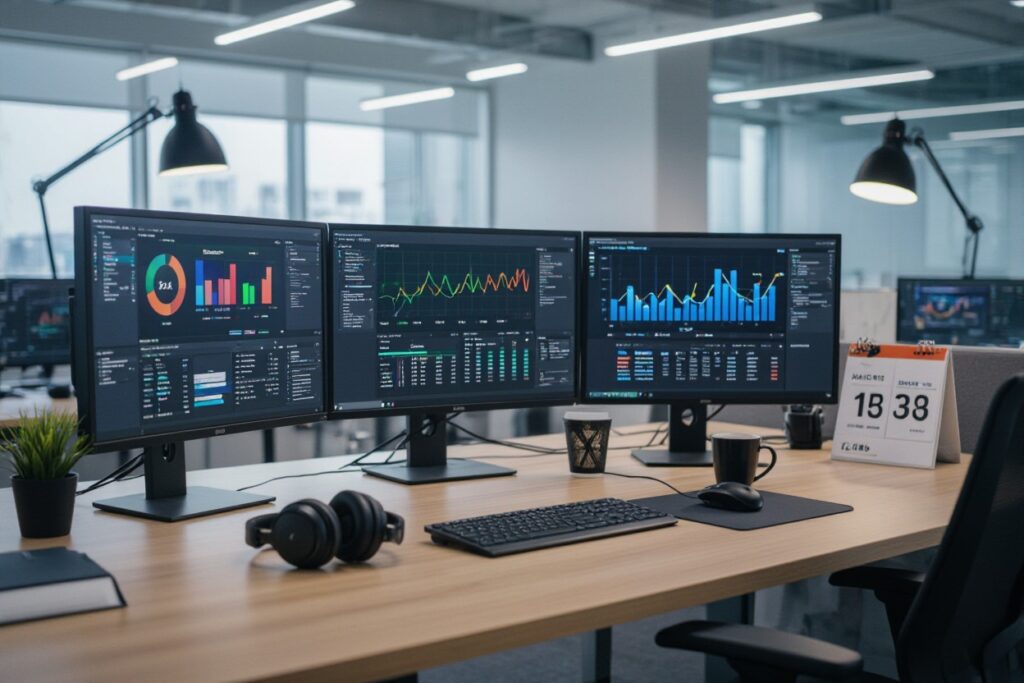This guide will show you proven strategies to maintain laser-sharp focus and transform your team’s productivity in today’s distraction-filled workplace.
Your role as a leader directly impacts how well your team performs, and small changes in your management approach can yield significant improvements in output quality and efficiency.
Whether you’re dealing with remote workers, hybrid teams, or in-office staff, you’ll discover practical techniques to boost engagement, minimize distractions, and create an environment where your team naturally excels.
Jump To Section
The Science of Focus: What Distractions Are Costing You

Cognitive Load and Its Impacts on Performance
Your brain processes an estimated 34GB of information daily, and each time your team switches tasks, they lose productivity. This cognitive burden accumulates throughout the day, leading to mental fatigue and decreased performance. Research from the University of California Irvine shows that after being interrupted, workers take an average of 23 minutes to return to their original task fully.
When your team juggles multiple projects, responds to constant notifications, and tries to maintain complex workflows, their cognitive resources become depleted faster, resulting in lower creative output and an increase in errors.
Digital Distractions: Unseen Saboteurs
Modern workplaces face an unprecedented assault from digital interruptions. The average employee checks their email 11 to 36 times per hour. These micro-interruptions might seem harmless, but they create a constant state of partial attention that reduces your team’s ability to engage in deep, meaningful work.
Each notification, chat message, or email alert triggers a dopamine response, creating addictive checking behaviors that fragment attention and diminish productivity.
The financial impact of these digital distractions is staggering. Businesses lose an estimated $650 billion annually to workplace distractions. Implementing structured digital boundaries can help reclaim this lost productivity and create space for sustained concentration.
How to Craft the Ideal Work Environment for Productivity
Physical Space: Design Your Team’s Success
Your office layout directly impacts how well your team collaborates and focuses. Research shows that teams working in well-designed spaces experience up to 32% higher productivity.
Start by creating dedicated zones. Quiet areas for deep work, collaborative spaces for brainstorming, and comfortable break rooms for recharging. Natural light exposure through windows or smart lighting systems can boost your team’s energy levels by 40% while reducing eye strain and headaches.
Consider implementing flexible seating arrangements where team members can choose between standing desks, traditional workstations, or informal meeting areas based on their tasks.
The right acoustics matter too. Installing sound-absorbing panels and creating buffer zones between different departments can reduce noise distractions by up to 50%, allowing for better concentration during complex tasks.
Digital Workspace: Tools that Enhance Concentration
Your digital environment needs just as much attention as your physical space. Equip your team with project management platforms like Asana or Monday.com to streamline workflows and reduce context-switching. Time-tracking tools combined with focus apps can help team members understand their peak productivity hours and protect them from unnecessary interruptions.
Cloud-based collaboration tools enable seamless file sharing and real-time editing, eliminating the frustration of version control issues. Companies using integrated digital workspaces require fewer meetings and have more efficient communication. Set up automated notifications wisely. Batch updates at specific times rather than allowing constant interruptions throughout the day.
Consider implementing digital wellness features like screen time tracking and break reminders. Tools such as RescueTime or Focus@Will can help your team maintain productivity while avoiding digital burnout.
Time Management Mastery: Techniques for Trying Times
The Pomodoro Technique: How Short Bursts Can Drive Results
Breaking down work into focused 25-minute segments followed by short breaks has revolutionized how teams tackle complex projects. The Pomodoro Technique leverages your team’s natural attention spans. By implementing this method, you’ll notice team members completing tasks more efficiently while maintaining higher energy levels throughout the day.
Prioritization Frameworks: The Eisenhower Matrix
The Eisenhower Matrix divides tasks into four quadrants based on urgency and importance, helping your team make better decisions about task allocation. By categorizing work as “urgent and important,” “important but not urgent,” “urgent but not important,” and “neither urgent nor important,” you’ll enable your team to focus on high-impact activities while reducing time spent on low-value tasks.
To maximize the matrix’s effectiveness, schedule weekly team reviews where members can share their task categorizations and collaborate on workload distribution. This practice not only improves individual time management but also reduces work overlap and increases team coordination. Your team will naturally begin to identify patterns in their work, leading to more strategic resource allocation and improved project outcomes.
Fostering Accountability and Motivation in Your Team
Building a culture of accountability transforms how your team approaches their work and delivers results. The key lies in creating an environment where team members feel empowered to take the initiative while understanding their responsibilities to the broader group.
Goal Setting: How to Set Targets that Inspire Action
Break down your team’s objectives into specific, measurable milestones that align with both individual strengths and company priorities. For example, rather than setting a vague goal like “improve customer satisfaction,” establish concrete targets such as “reduce response time to customer inquiries by 25% within 60 days” or “achieve a 90% positive feedback rate on all client deliverables.”
Involve your team members in the goal-setting process by asking them to propose their own targets and timelines. This collaborative approach results in higher commitment levels and helps team members develop a personal stake in achieving outcomes.
The Role of Regular Check-ins: Keeping the Momentum
Schedule brief, focused check-ins at consistent intervals. Whether daily 15-minute stand-ups or weekly 30-minute progress reviews. These touchpoints give your team regular opportunities to share updates, flag potential roadblocks, and realign priorities.
Structure your check-ins around three key questions: What progress has been made since the last meeting? What obstacles are currently in the way? What support is needed to move forward? This framework keeps conversations productive while ensuring no team member gets stuck without assistance.
Use digital tools to track progress between check-ins, allowing team members to update their status asynchronously. Platforms like Trello or Asana help visualize workflow and create transparency around individual contributions, making it easier to identify where additional support or resources might be needed. This combination of regular face time and ongoing digital updates maintains momentum while respecting everyone’s time and work patterns.

Transformative Leadership: Guiding Your Team’s Focus
Leading by Example: The Power of Attention
Your own focus habits directly shape your team’s behavior. Start by blocking out dedicated deep work time on your calendar and communicating these boundaries clearly. When team members see you consistently protecting your focus time and producing high-quality work, they naturally begin to mirror these positive habits.
Create visible systems that showcase your prioritization methods. Share your task management approach, whether it’s using the Eisenhower Matrix or time-blocking techniques. Make it a practice to decline non-vital meetings and encourage your team to do the same. By demonstrating that focused work takes precedence over constant availability, you establish a culture where deep work is valued and protected.
Empathetic Communication: Understanding Your Team’s Challenges
Regular one-on-one conversations with team members reveal individual obstacles to focus and productivity. During these check-ins, ask specific questions about their work environment, peak energy hours, and potential distractions. This intelligence allows you to make targeted adjustments to support each person’s optimal working conditions. For instance, you might discover that morning meetings disrupt your designer’s creative flow, while your developer needs longer uninterrupted blocks in the afternoon.
Implement feedback loops that give your team a voice in shaping their work environment. Use anonymous surveys or group discussions to identify common focus-draining issues. Teams that feel heard show higher engagement levels and are more likely to adopt new productivity practices. Your role is to translate these insights into actionable changes, whether that means adjusting meeting schedules, modifying communication protocols, or investing in focus-enhancing tools.
Build trust by acknowledging focus challenges openly and sharing solutions collaboratively. Create a shared document where team members can contribute their own productivity tips and tricks. This approach not only generates practical solutions but also fosters a supportive environment where everyone contributes to the team’s success. When team members see their suggestions implemented, they become more invested in maintaining high productivity standards.
Final Thoughts on How to Get Your Team to Focus
Your ability to guide your team toward peak productivity hinges on implementing clear strategies while maintaining a supportive environment. By setting well-defined goals, establishing effective communication channels, and providing the right tools and resources, you can create a workspace where your team naturally gravitates toward focused, productive work. Your consistent monitoring and adjustment of these approaches will ensure long-term success in maintaining team efficiency.
When you combine structured productivity methods with flexibility and understanding of individual work styles, you’ll find your team becoming more engaged and delivering better results. The key lies in your commitment to these practices and your willingness to adapt them as your team evolves.


